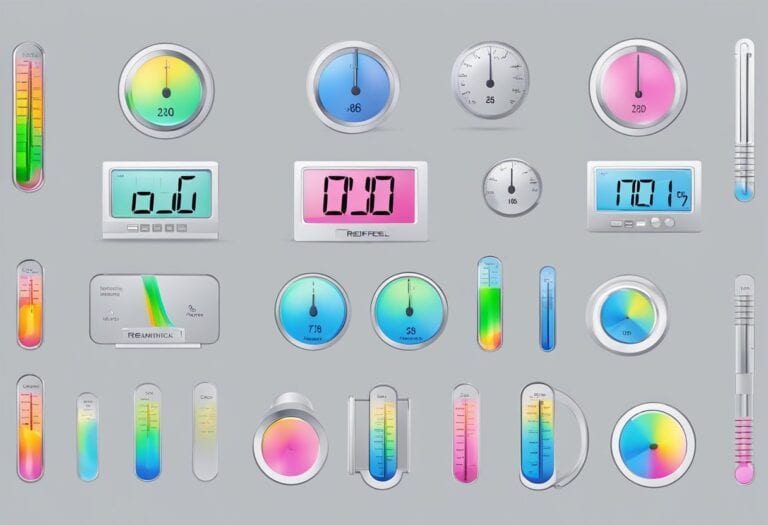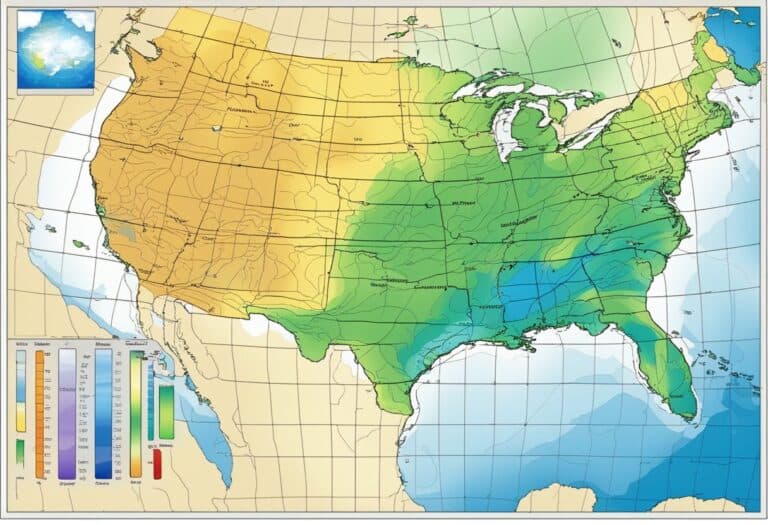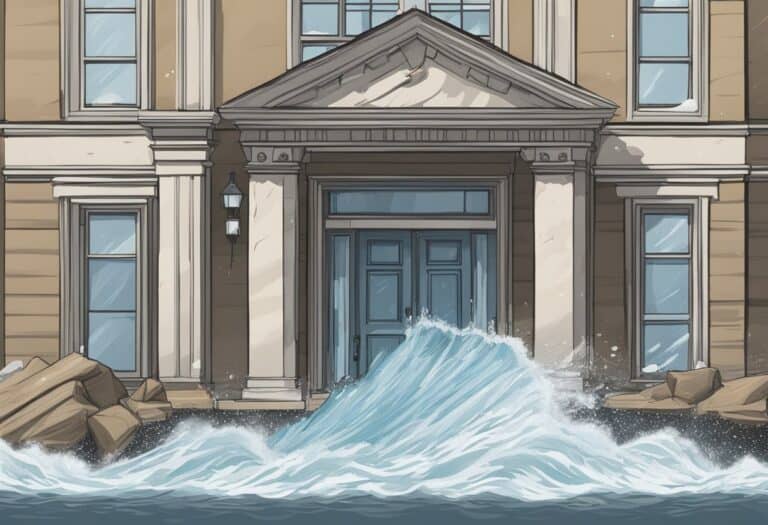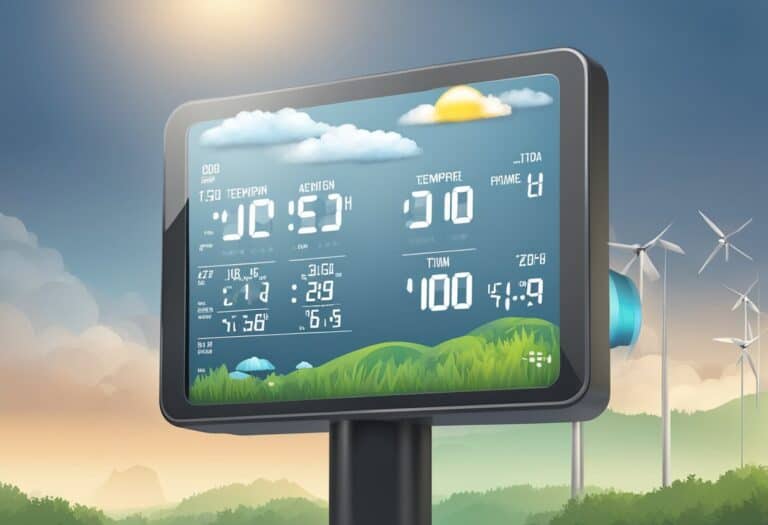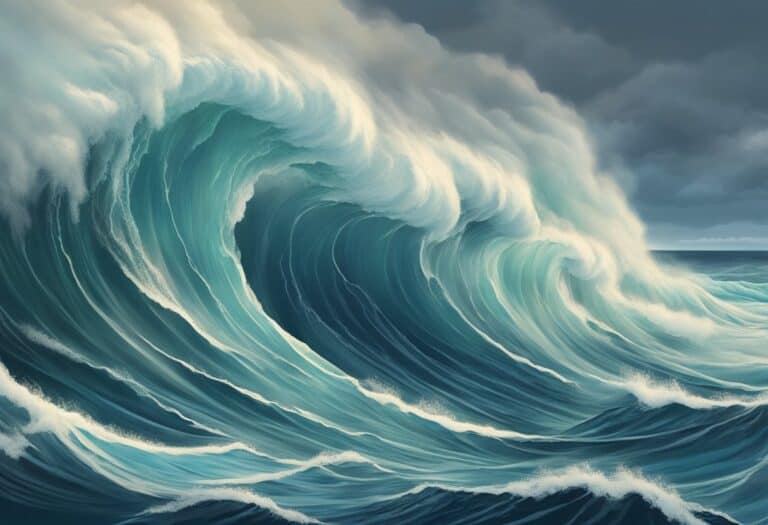Freezing rain is a type of precipitation that occurs when a layer of warmer air exists above a sub-freezing layer at the surface.
This weather phenomenon happens as snowflakes fall through the warm air and melt into raindrops. If these raindrops then make contact with surfaces that are at or below 0°C, they instantly freeze upon impact, resulting in a glaze of ice. This process can create hazardous conditions, particularly during the winter months.
The impacts of freezing rain are notable, primarily due to the layer of ice it forms on everything it touches, from roads and power lines to trees and vehicles. The weight of the ice can cause trees to snap and utility lines to break, leading to power outages and unsafe driving conditions.
Understanding the meteorological conditions that lead to the formation of freezing rain is essential for accurate forecasting and implementing appropriate safety measures.
Freezing rain, a perilous winter phenomenon, forms when snowflakes melt into rain in a warm air layer, then freeze upon hitting sub-zero surfaces, creating ice glaze. This can lead to severe infrastructure damage and treacherous conditions, necessitating awareness of its meteorological causes for safety and preparedness.
Freezing Rain Formation
Freezing rain is a weather phenomenon that occurs under specific atmospheric conditions. Understanding the formation of freezing rain involves grasping the interplay between temperature layers and the types of precipitation that result from these conditions.
Temperature Variations
Temperature layers within the atmosphere are critical to the development of freezing rain. You might find it surprising that freezing rain begins its journey as snow. The snow falls through a layer of warm air, turning it into liquid raindrops. Then, as the rain falls into a subfreezing layer of air just above the surface, it becomes supercooled but remains liquid.
Precipitation Types
When supercooled raindrops make contact with a surface that is at or below freezing temperature, they instantaneously freeze, creating a glaze of ice. It is this type of precipitation that differentiates freezing rain from other forms like sleet or hail. While sleet and hail are frozen before they hit the ground, freezing rain freezes upon impact.
Atmospheric Conditions
The atmospheric conditions necessary for freezing rain are rather particular. You have a warm layer aloft sandwiched between layers of cold air. These conditions are often associated with weather fronts or low pressure systems where warm and cold air masses collide. For more in-depth information, the conditions present during freezing rain events are analyzed in this observational and theoretical study.
Supercooled Raindrops
The phenomenon of supercooling allows liquid raindrops to exist at temperatures below the normal freezing point of water. This precarious state is what sets the stage for the formation of ice upon impact with surfaces like trees, power lines, or roads. The interaction of supercooled droplets with freezing surfaces results in the dangerous glazing known as freezing rain, which can cause widespread damage and hazardous conditions.
Impact on Infrastructure
Freezing rain is a significant meteorological phenomenon that can have far-reaching effects on various aspects of infrastructure. As you encounter an ice storm or winter storm, the weight of ice accumulation can pose severe risks, leading to damage and outages.
Power Systems
When ice coats power lines, it can lead to power outages due to the added weight and the potential for tree branches to snap and fall onto lines. For instance, during extreme weather events, as many as 35 extra-high voltage lines can be affected, making the situation particularly hazardous for electricity providers.
Travel and Transportation
Your travel can become dangerous during a freezing rain event. Roadways and bridges can develop a slick layer of ice, making traction for motorists and drivers poor and increasing the likelihood of accidents. In addition, icing presents challenges for aircraft, as it affects the ability to take off, land, and maintain control during flight.
Buildings and Structures
The impact of freezing rain on buildings and structures involves ice accumulation leading to potential damage. Freeze-thaw cycles can degrade the structural integrity over time, threatening your safety within or around these structures. The adaptation to the weathering of infrastructure in a changing climate is a growing concern.
Agriculture and Vegetation
Your vegetation and agriculture aren’t immune to the dangers of freezing rain. Ice can coat and accumulate on tree limbs and branches, causing them to break under the weight of ice. This not only poses a threat to power lines when branches fall but also can cause long-term damage to your crops and vegetation.
Meteorological Classification

When you encounter winter weather reports, it’s important to understand their meteorological classification to gauge the level of impact on your area. Classification criteria include the severity of ice accumulation and the likelihood of hazardous conditions.
Ice Storm Criteria
Freezing rain events become classified as ice storms when they result in a quarter-inch or more of ice accumulation. The National Weather Service (NWS) has specific thresholds: minor ice accumulations (< 0.25 inch), significant accumulations (0.25 – 0.5 inch), and severe accumulations (> 0.5 inch). These categories help you to anticipate potential damages and transportation issues.
Winter Weather Advisories
For less severe situations than ice storms, the NWS issues Winter Weather Advisories. These advisories are a warning that although conditions might not meet ice storm criteria, freezing rain is expected, and you should prepare for slippery roads and potential travel disruptions. The weight of ice can snap tree branches and down power lines, so stay informed and cautious.
Regional Variations
The occurrence and classification of freezing rain, winter storms, and related advisories can vary by region within the USA. The Midwest and areas near the Appalachian Mountains are particularly susceptible to winter precipitation events. Your location governs the specific terminology and criteria the NWS will use and helps you understand the unique challenges you may face during a winter weather event.
Safety and Preparedness
Freezing rain presents significant risks, from treacherous driving conditions to the threat of power outages. Understanding how to navigate this hazardous weather is crucial to ensure your safety during an ice storm.
Driving and Walking
When freezing rain is forecast, consider postponing non-essential travel as ice can form a glaze over roads and walkways, creating slippery surfaces that reduce traction. If you must drive, equip your vehicle with tires designed for winter conditions to improve grip. Keep in mind that black ice can make roads look clear when they are actually coated in a thin, dangerous layer of ice. Increase your following distance and reduce speed to account for lower visibility and traction.
Driving Tips:
- Install winter tires.
- Reduce speed accordingly.
- Maintain greater following distance.
Walking Safely:
- Use footwear with good grip.
- Take shorter, deliberate steps.
- Avoid carrying heavy items that could cause imbalance.
Emergency Services
Emergency response teams are prepared to handle calls related to ice storms and power outages. They work to clear hazardous conditions quickly, but heavy demand during a storm may lead to delays. Familiarize yourself with local emergency numbers and have a battery-powered radio ready to receive updates if power outages occur.
- Be Prepared:
- Keep emergency numbers handy.
- Own a battery-powered or hand-crank radio.
- Stay informed about local emergency protocols.
Home Safety Tips
Your home should be prepped before an ice storm hits. Sub-freezing air and cold air damming can lead to rapid freezing and refreeze situations, posing a risk even after the precipitation ends. Apply salt or sand on walkways to improve traction, insulate pipes to prevent freezing, and have alternative heating sources available in case of power outages.
- Prepare Your Home:
- Insulate water pipes.
- Keep salt or sand at the ready.
- Ensure alternative heat sources are safe and functional.
$IFnBy maintaining a well-informed and vigilant approach to the threats posed by freezing rain, you can greatly reduce the chances of life-threatening situations and maintain safety.
Environmental Impact
When a freezing rain event occurs, the ecological balance and the characteristics of surface water and soil can be significantly altered. Your understanding of these impacts can help in preparing for and mitigating the effects of such weather phenomena.
Ecological Effects
Ice Accumulation: Freezing rain leads to the build-up of ice on trees and shrubs, causing damage to tree limbs and other vegetation. The weight of the ice can break branches, destabilizing ecosystems and potentially altering habitats. For example, studies have shown that freezing rain events can be detrimental to both flora and fauna, as ice coating can impede the ability of wildlife to forage and can damage plant tissue.
Surface Water and Soil
-
Gravity and Surface Impact: As the ice melts, the influx of liquid water can alter the composition and temperature of surface water bodies, impacting aquatic life. Additionally, the sudden increase of water can lead to soil erosion.
-
Refreeze and Soil Structure: In certain conditions, the melted water will refreeze on the ground, affecting the soil‘s ability to absorb water. Over time, this can lead to a compaction of the soil and disturb the natural water infiltration rates, further influencing the ground‘s fertility and stability.
Understanding these specific impacts helps you appreciate the broader environmental significance of freezing rain beyond its immediate hazardous effects on infrastructure and travel.
Scientific Research
In the realm of scientific research, particular emphasis has been placed on understanding the mechanisms behind freezing rain, its climatological patterns, the advancements in forecasting techniques, and the effects on materials. These insights are crucial for mitigating the risks associated with winter weather phenomena.
Climatology Studies
Your awareness of freezing rain events is enriched by climatology research that systematically catalogs and analyzes atmospheric conditions. A notable study on general conditions during freezing rain concluded that the differences in the necessary atmospheric conditions for freezing rain versus ice pellets are significant and noteworthy. Freezing rain events have been extensively documented to develop a climatology that helps us understand their regional and national distribution.
Advancements in Forecasting
Enhancements in predicting winter storms have been attributed to advancements in atmospheric research and technology. Your safety during winter storms can be improved with better forecasting methods, such as those developed by researchers studying regional and local influences on freezing precipitation. A concrete example is the investigation of local and synoptic environments, which leads to an increased ability to forecast freezing drizzle, freezing rain, and ice pellet events. Improvements in forecasting align closely with efforts by meteorological organizations, such as the National Weather Service (NWS), to accurately predict these hazardous weather events.
Materials Science
Your understanding of the impact of freezing rain on infrastructure is largely influenced by materials science research. This field of study deals with the glaze ice or clear ice accumulation on structures, such as power lines, and the development of new materials to counteract this. For instance, research into the accretion of ice on conductors proposes models to estimate ice loads, which are vital for the design and maintenance of infrastructure in areas prone to winter weather phenomena. The importance of materials science in relation to freezing rain is exemplified by studies that develop models for freezing rain ice loads on different surfaces.
Historical Weather Events
Freezing rain and ice storms have been noted for their destructive power, often leading to significant damages due to the accumulation of ice. Your understanding of historical weather events involving freezing rain will be enhanced by examining notable ice storms and extreme precipitation records.
Notable Ice Storms
In recent history, several severe ice storms have struck the United States, especially in the Midwest. For instance, the Great Ice Storm of January 1998 struck the Northern U.S. and parts of Eastern Canada, causing billions in damages and leaving millions without power.
December 2002 brought an ice storm that affected the Carolinas through the Northeast, leading to widespread power outages and numerous travel disruptions.
Extreme Precipitation Records
During an ice storm, the precipitation begins as snowflakes high in the atmosphere but melts into rain as it falls through a warm layer. It then refreezes upon hitting the cold ground or surfaces, resulting in a layer of ice.
For example, the Freezing Rain Event of 2006 was highlighted by researchers for its exceptional severity. According to point annual averages, there was a decrease in such events since the mid-1960s, but intense occurrences like this still happen.
Another event worth noting involved the temporal and spatial variations of freezing rain from 1948–2000 across the contiguous United States, revealing patterns and fluctuations in freezing rain events.
Frequently Asked Questions
Freezing rain is a type of precipitation that can create hazardous conditions. Understanding it helps you stay safe during winter weather events.
What is the distinction between freezing rain and hail?
Freezing rain is rain that becomes supercooled and freezes upon impact with cold surfaces. Hail, on the other hand, forms during thunderstorms when water droplets are carried upward by updrafts and freeze in colder upper layers of the atmosphere.
What conditions are necessary for the formation of freezing rain?
The formation of freezing rain requires a layered atmospheric temperature profile where warm air is sandwiched between colder layers above and below. Precipitation must fall through the warm layer, melting into rain, and then pass through sub-freezing air near the ground to supercool.
How can freezing rain impact road safety and driving conditions?
Freezing rain creates a glaze of ice on roads and other surfaces, significantly reducing traction. This can lead to hazardous driving conditions, where stopping distances increase, and the likelihood of skidding or losing control is high.
In which regions of the United States is freezing rain most common?
Freezing rain is most common in the Northeast, Midwest, and some areas of the Pacific Northwest. It is less common in regions where cold air is not as prevalent.
What are the primary dangers associated with freezing rain?
The primary dangers include the buildup of ice on roads, walkways, power lines, and tree branches. This accumulation can lead to traffic accidents, pedestrian falls, and power outages due to downed lines and tree limbs.
Why does freezing rain lead to different hazards than snow?
Freezing rain leads to different hazards because it forms a solid sheet of ice, which can be more treacherous than snow. Snow tends to provide more traction and is less likely to cause widespread power outages and damage from falling tree branches.


